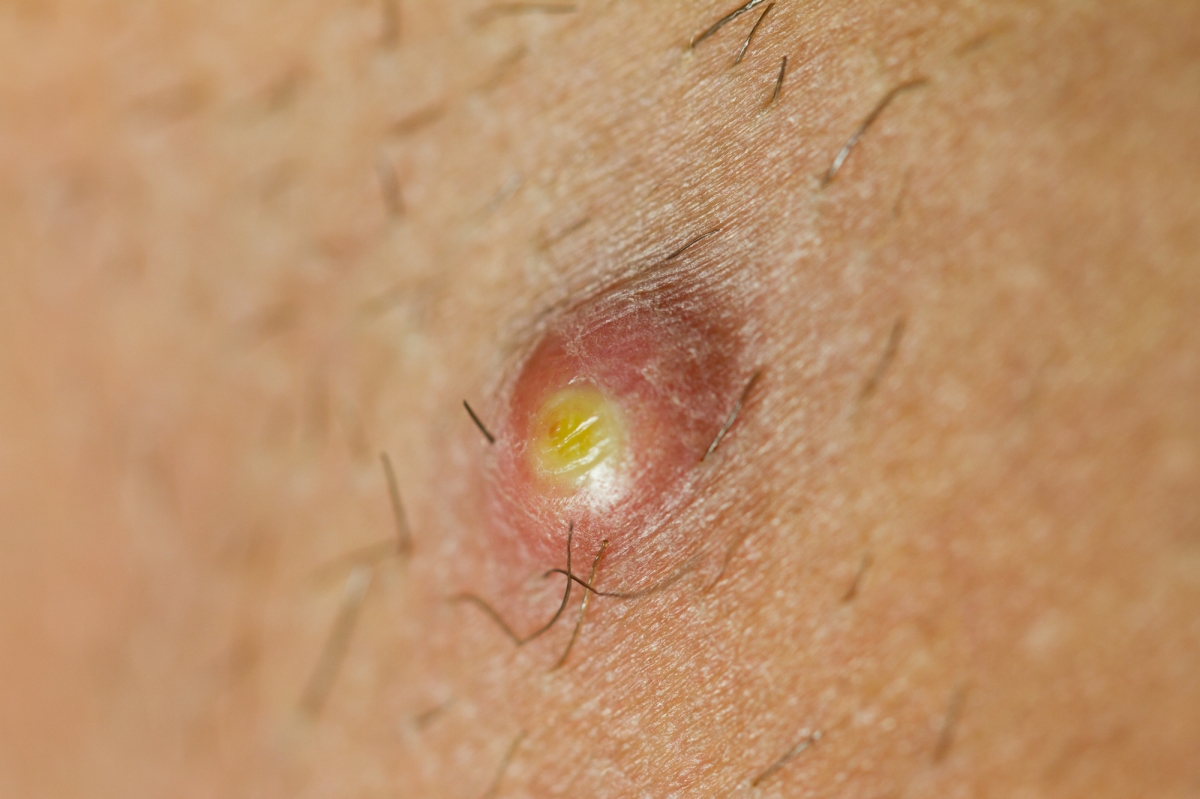A boil is a painful, pus-filled bump that forms under your skin when bacteria infect and inflame one or more of your hair follicles. Boils usually begin as red bumps, which quickly increase in size and fill with pus. A carbuncle is a cluster of boils that form a connected area of infection under the skin.


boil

carbuncle
Cause:
Boils are usually caused by the bacteria Staphylococcus aureus (staph infection), but other bacteria and fungi can cause them too. Bacteria enter your skin through a cut or a hair follicle (the opening in your skin where hair grows out). Your body’s immune system responds by sending infection-fighting white blood cells to the area. The white blood cells build up, along with damaged skin, to form pus.
Most people with boils are otherwise healthy and have good personal hygiene. They do however carry Staphylococcus aureus on the surface of their skin (staphylococcal carrier state). Why this occurs is usually not known, but it is estimated that 10–20% of the population are staphylococcal carriers. Staphylococcus aureus is most commonly carried in the nostrils, armpits, between the legs and in the cleft between the buttocks. It may be transferred to other sites from the nostrils via the fingernails.
Tiny nicks or grazes or something rubbing against the skin can inoculate the bacteria into the wall of a hair follicle which is a weak point in the skin’s defense. Once inoculated, the bacteria cause a boil which goes on to run its usual course of about 10 days.
Boils vs. pimples. Pimples are caused by clogged pores, but boils stem from an infection. That’s why you might notice boils around scratches or cuts, unlike pimples. Pimples aren’t contagious, but boils can be. A boil will likely grow faster than a pimple and hurt more and it won’t get better when you use pimple treatments.

Pimple
Boils vs. cysts. A cyst isn’t caused by an infection. It doesn’t hurt and is usually harmless. Cysts usually grow more slowly than boils. Fluid might come out if you squeeze a cyst, but it’s not whitish-yellow pus, which is a sign of infection. Cysts aren’t contagious, but you can spread boils to others.

cyst
Common Boil Locations
Boils in the groin area: Boils can affect the skin folds of the groin, the pubic area, and the lips and folds of the vagina. This area has lots of hair follicles and can be prone to chafing, especially if you wear tight-fitting clothes. You can also develop a boil after you get a cut or ingrown hair due to shaving this area.

Boils on buttocks: Boils frequently affect the buttocks due to hair follicles, sweat, and friction in the area. Dirty underwear could make a boil here more likely.
Boils on the face: Boils on your face are different from cysts and pimples, though they can look similar. Cysts are filled with fluid, while a pimple is the result of a clogged pore. Cysts and pimples aren’t contagious like boils can be.

Boil on eyelid: If a boil occurs here, it’s called a stye, and it can be painful. You treat them similarly to the way you treat a boil anywhere else. If it doesn’t go away on its own, a dermatologist can prescribe an antibiotic cream or eye drops.

Other areas where boils often appear include:
Breasts, Armpits, Shoulders, Legs




Signs and symptoms of a boil usually include:
- A painful, red bump that starts out small and can enlarge to more than 2 inches (5 centimeters)
- Reddish or purplish, swollen skin around the bump
- An increase in the size of the bump over a few days as it fills with pus
- Development of a yellow-white tip that eventually ruptures and allows the pus to drain out
Risk factors
Although anyone — including otherwise healthy people — can develop boils or carbuncles, the following factors can increase your risk:
Close contact with a person who has a staph infection. You’re more likely to develop an infection if you live with someone who has a boil or carbuncle.
Diabetes: This disease can make it more difficult for your body to fight infection, including bacterial infections of your skin.
Other skin conditions: Because they damage your skin’s protective barrier, skin problems, such as acne and eczema, make you more susceptible to boils and carbuncles.
Compromised immunity: If your immune system is weakened for any reason, you’re more susceptible to boils and carbuncles.
Complications:
Rarely, bacteria from a boil or carbuncle can enter your bloodstream and travel to other parts of your body. The spreading infection, commonly known as blood poisoning (sepsis), can lead to infections deep within your body, such as your heart (endocarditis) and bone (osteomyelitis).
Prevention
It’s not always possible to prevent boils, especially if you have a weakened immune system. But the following measures may help you avoid staph infections:
- Wash your hands regularly with mild soap. Or use an alcohol-based hand rub often. Careful hand-washing is your best defense against germs.
- Keep wounds covered. Keep cuts and abrasions clean and covered with sterile, dry bandages until they heal.
- Follow a balanced healthy diet with meat, plenty of fruit and vegetables.
- Avoid smoking.
- Change your underclothes and night attire regularly.
- Consider modifying leisure activities that cause sweating and friction from clothing, such as squash and jogging.
- If you are iron deficient, a course of iron tablets may help reduce infection.
- 1000 mg of vitamin C each day has also been advocated to improve deficient neutrophil function.
- Avoid sharing personal items. Don’t share towels, sheets, razors, clothing, athletic equipment and other personal items. Staph infections can spread via objects, as well as from person to person. If you have a cut or sore, wash your towels and linens using detergent and hot water with added bleach, and dry them in a hot dryer.
Treatment of boils depends on their severity:
Apply warm compresses: Soak a washcloth in warm water and then press it gently against the boil for about 10 minutes. You can repeat this a few times throughout the day. Once you see the pus at the center (that’s called “bringing a boil to a head,” it’ll probably burst and drain soon. This usually occurs within 10 days after you see the head.
Use a heating pad: A heating pad can help the boil start to drain, too. Put the heating pad over a damp towel and lay it on the affected area. It may take up to a week for the boil to start opening and draining the pus. Keep applying heat, either with a heating pad or compress, for up to 3 days after the boil opens.
Antiseptic or antibacterial soap in your daily bath or shower for a week then twice weekly for several weeks. The cleanser may cause a little dryness.
Use a hand sanitizer regularly to reduce the chance of reinfecting yourself or others with contaminated hands.
Antiseptic or antibiotic ointment or gel to apply to the inside of the nostrils.
Wipe the entire skin surface daily for a week with 70% isopropyl alcohol in water (this will make the skin dry).
Apply a topical antiseptic such as povidone iodine or chlorhexidine cream to the boils and cover with a square of gauze.
Your doctor may prescribe an oral antibiotic (usually the penicillin antibiotic flucloxacillin), sometimes for several weeks.
Other members of the family with boils should also follow a skin cleansing regime. Your doctor may also advise the family to apply topical antibiotics to their nostrils in case they are Staphylococcus aureus carriers as well.
If the boils fail to clear up, a swab should be taken for microbiological culture, in case of methicillin (meticillin) resistant staphylococci.
Sometimes, special antibiotics may be prescribed on the recommendation of a specialist, including fusidic acid, clindamycin, rifampicin and cephalosporins.
Most boils will disappear on their own or with simple home treatment. In rare cases, the bacteria can enter your bloodstream and affect other parts of your body which could lead to more serious infections.


